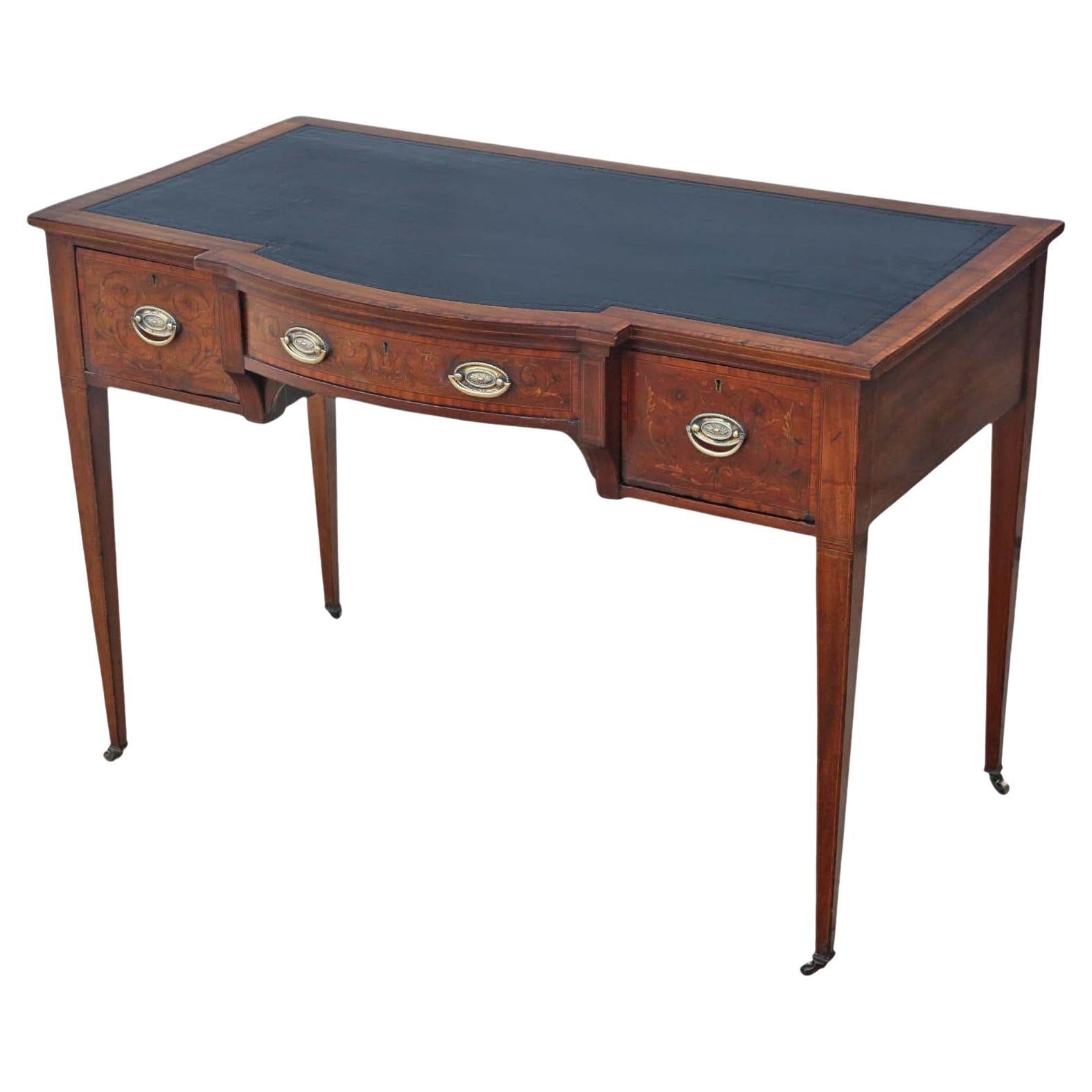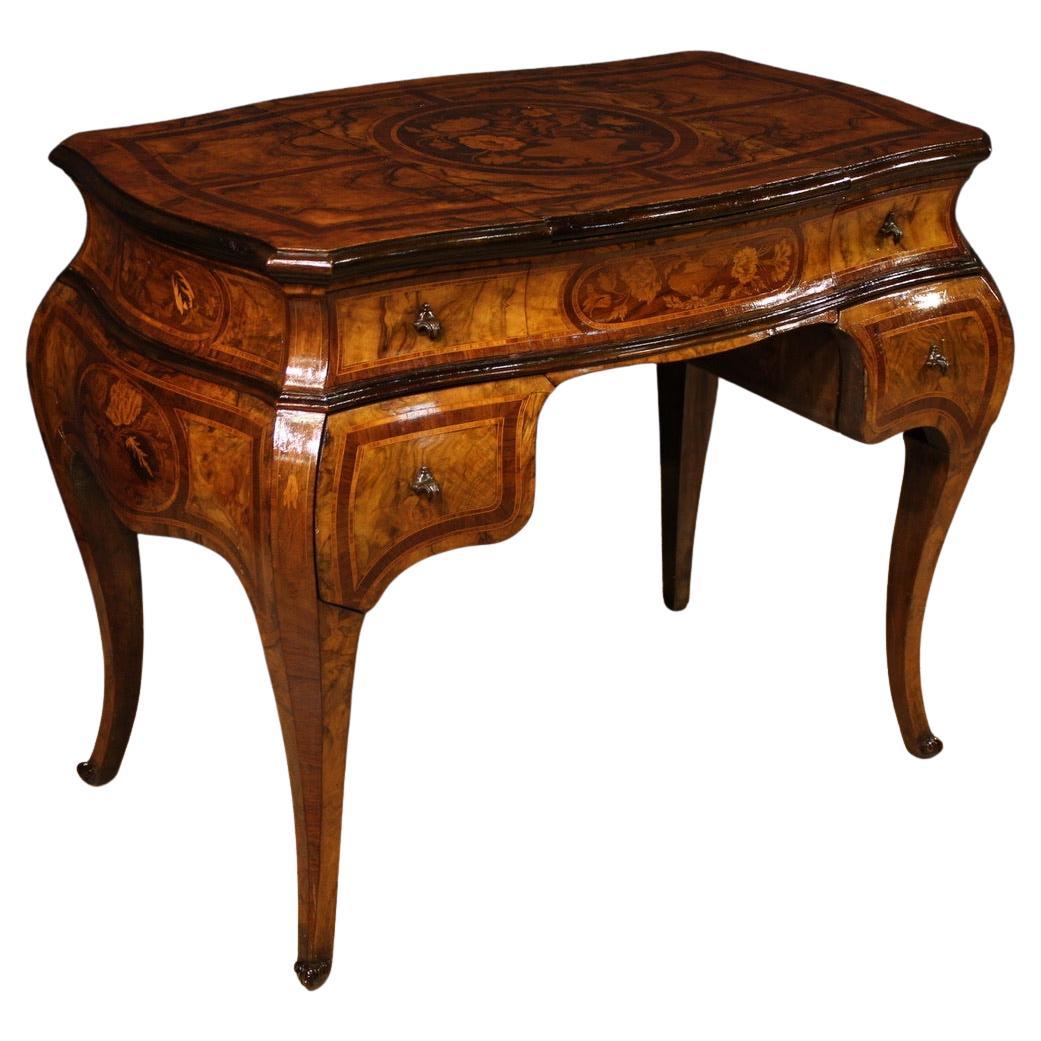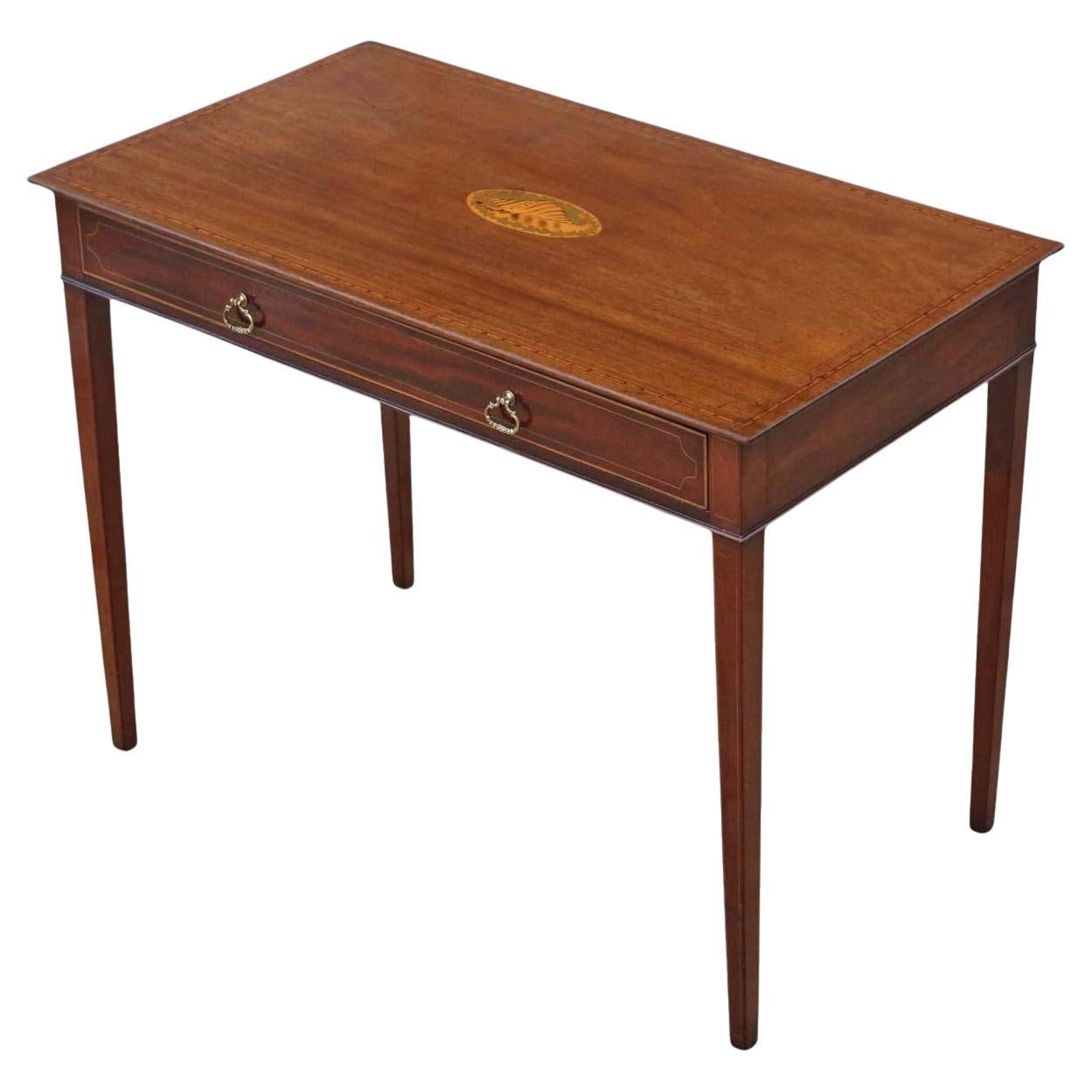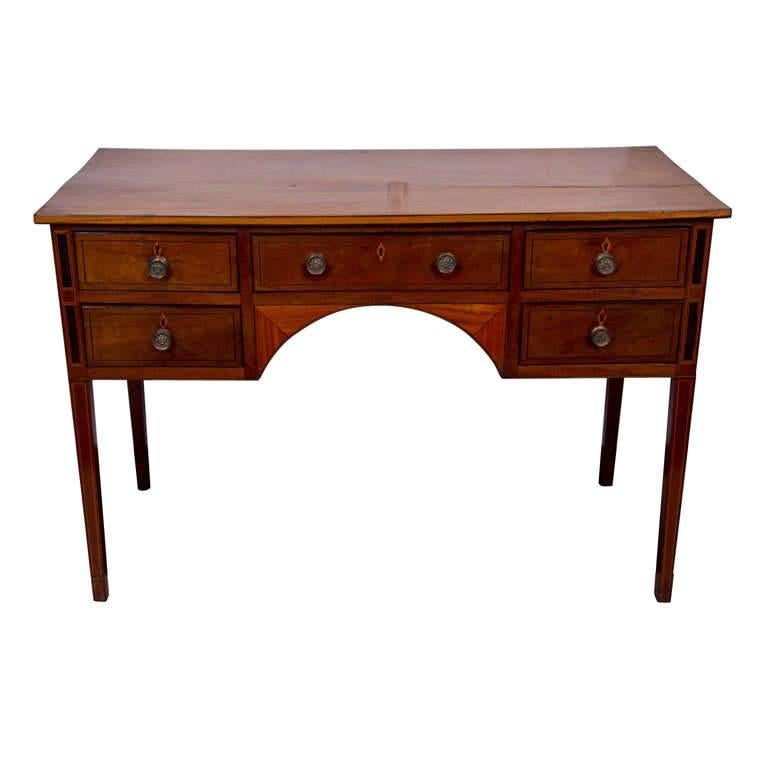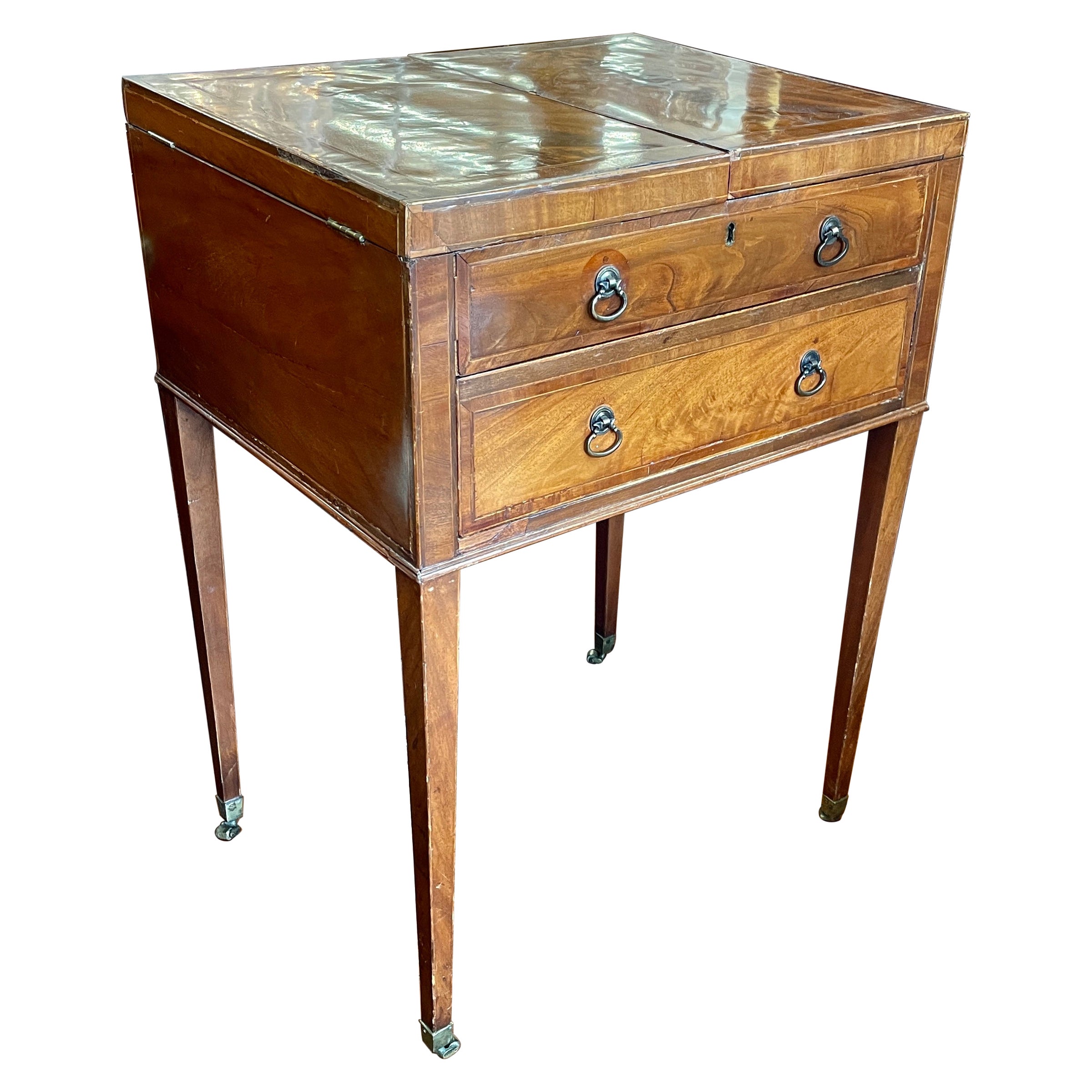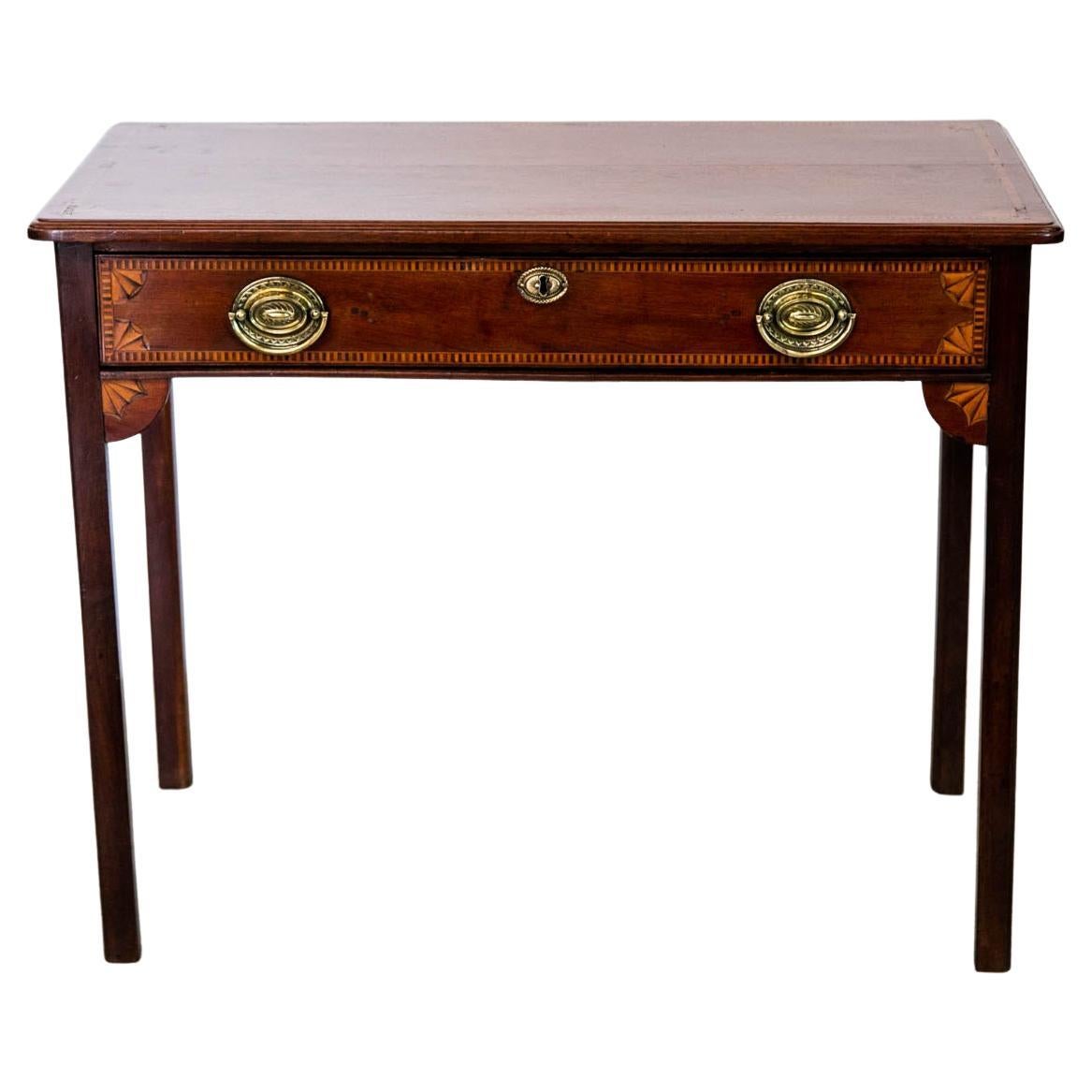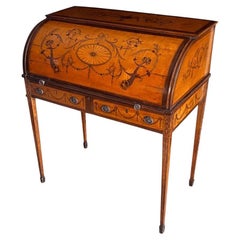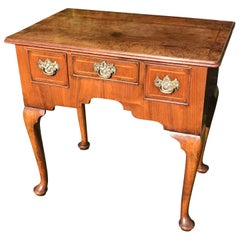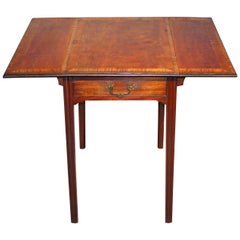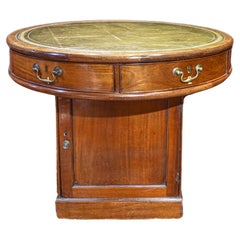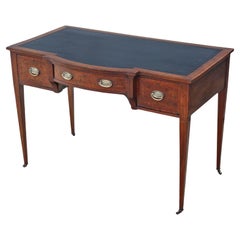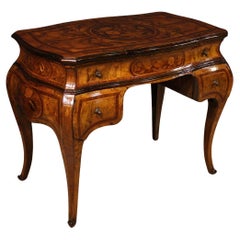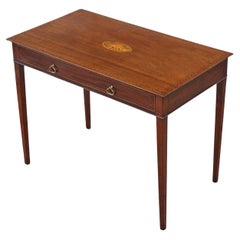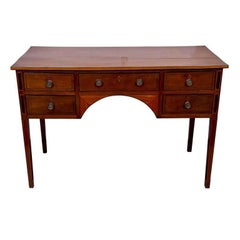Items Similar to George III Serpentine Inlaid Writing Dressing Table
Video Loading
Want more images or videos?
Request additional images or videos from the seller
1 of 14
George III Serpentine Inlaid Writing Dressing Table
$6,894.66
£4,950
€5,853.51
CA$9,385.35
A$10,519.77
CHF 5,477.34
MX$128,450.94
NOK 69,542.29
SEK 65,919.83
DKK 43,673.53
Shipping
Retrieving quote...The 1stDibs Promise:
Authenticity Guarantee,
Money-Back Guarantee,
24-Hour Cancellation
About the Item
A George III-period sabicu and goncalo alves serpentine writing / dressing table. In the manner of master cabinet-maker Pierre Langlois, circa 1770.
Great color, condition and surface patination.
The serpentine top inset with a blue, gilt-tooled leather writing surface.
The frieze with one long silk-lined, side-fitted cockbeaded drawer below a simulated slide.
The reverse simulated to match with a working slide to the front, also fitted with a blue tooled-leather writing surface. Raised on elegant slender cabriole legs in the French taste, with four sabicu-inlaid reserves, and united by a concave-fronted platform stretcher. The reverse with a rising slide fitted with a pleated blue silk panel. Apparently retaining its original brass mounts.
This lovely English table would make a useful small side table / lamp table / occasional table. Attributable to John Cobb (c.1710–1778), a notable English cabinetmaker.
Measures:
Height 29.5" (75 cm)
Width 25" (63 cm) max
Depth 17" (43 cm).
A closely related antique writing table, lacking its screen, sold at Christies, London 13th April, 1989, lot 68, for £7,700.00.
See a similar table sold in New York, 16th April 2002, lot 41, sale no. 1146, for £8,500.00.
A very similar table, but lacking its under-tier, was sold in Christies, New York, 21 Oct 1999, lot 87, for $27,600.
For further reading see below:
This form of elegant ladies writing / dressing table is based on mid-18th century French designs introduced by the eminent cabinet-maker Pierre Langlois (fl. 1759-1781) and illustrated on his trade card. Vis. V & A museum, London.
A table of the same distinctive form is illustrated in L. Synge 'The Mallett Millennium' (Suffolk, 1999) p. 176, pl.21.
Langlois must have trained in one of the best Paris marquetry workshops, possibly that of Jean-Francois Oeben (1721-1763). Langlois shared his London premises in Tottenham Court Road with his son-in-law, the bronze caster and gilder Dominique Jean, who made the mounts for his furniture. Langlois’ London clients included John Russell, 4th Duke of Bedford (1710-1771), George William, 6th Earl of Coventry (1722-1809), and Horace Walpole. He sent furniture to Lady Louisa Connolly in Ireland at Castletown House, County Kildare, and to Elizabeth, Duchess of Northumberland, at Alnwick Castle, Northumberland. Langlois is known to have supplied a similar table to the Duchess of Northumberland in the early 1760’s.
Literature:
Cobb’s designs in the Royal Collection at Buckingham Palace.
This table shows clear French influence adopted by both John Cobb and Thomas Chippendale.
A similar table was supplied to Nostell Priory in 1766 for Sir Rowland Winn (d. 1785), and is illustrated in A. Coleridge’s ‘Chippendale Furniture’ (London, 1968) plate 354.
For further refs. to Langlois see P. Thornton & W. Rieder ‘Pierre Langlois Ebeniste’ Part 4 (The Connoisseur, April 1972) p. 258, fig. 4.
Another eminent cabinet-maker associated with these Fine tables is John Cobb (1710-1778) of St Martin’s Lane, London, (son-in-law of Giles Grendey).
John Cobb syndicated in 1750 with William Vile. Vile and Cobb supplied furniture to the leading patrons of the day including George III and Queen Charlotte, the 1st Earl of Leicester at Holkham Hall, the 4th Duke of Devonshire at Chatsworth, and the 4th Duke of Bedford at Woburn Abbey.
A table of very similar form, but in tulip and rosewood, was made for Nostell Priory, Yorkshire, and is illustrated in Christopher Gilbert’s, ‘The Life and Work of Thomas Chippendale' (London, 1978) vol II, fig. 436.
For similarities in the treatment of the serpentine skirt, cockbeaded simulated drawers and delicately slender ‘French’ cabriole legs see Christie’s Catalogue of ‘The Samuel Messer Collection’ 5th December 1991, p. 153, lot 116, and lot 115, p. 152.
Ralph Edwards CBE FSA, in his 'Shorter Dictionary of English Furniture' (Fourth edition 1972) illustrates on p. 611, fig. 5, a related ‘'Walnut Work Table on slender cabriole legs; screen pulls up; circa 1770 (Donaldson collection). Sheraton explains that “they are intended for a lady to write or work at near the fire, the screen part behind protecting the face".
References:
Gonçalo alves is a hardwood (from the Portuguese name). It is sometimes referred to as zebrawood or tiger wood - names that underscore the wood’s often dramatic, contrasting color scheme, that some compare to rosewood.
While the sapwood is very light in color, the heartwood is a sombre brown, with dark streaks that give it a unique look. The wood’s color deepens with prolonged exposure to light, and even the plainer looking wood has a natural lustre.
Two species are usually listed as sources for gonçalo alves: astronium fraxinifolium and astronium graveolens, although other species in the genus may yield similar wood. The amount of striping that is present may vary. All trees grow in tropical forests. Brazil is a major exporter of these woods.
Sabicu is the timber of at least two species of the genus lysiloma. Lysiloma sabicu (L.) Benth. It occurs sparingly in the Bahamas, Jamaica, Haiti, The Dominican Republic, and Cuba. It was named by George Bentham (1800-1884) from a Cuban specimen examined in 1854.
[1] Bentham went on to identify a second species, Lysiloma latisiliquum (L.) Benth., which grows best in the Bahamas.[2] The latter is commonly known as ‘wild tamarind’ or ‘false tamarind’. The wood of both species is similar, being mid-brown in color, sometimes with a reddish hue, heavy (specific gravity of 0.40-0.75)[3] hard and durable. Some timber is well figured, but most relatively plain. The wood has been used in construction, shipbuilding and in furniture making, although its weight is a distinct drawback for the latter purpose. The stairs of The Crystal Palace London in which The Great Exhibition of 1851 was held, were made of sabicu due to its durability. Despite the enormous traffic that passed over them, the wood at the end was found to be little affected by wear.
There is some confusion in the published literature between L. sabicu and L. latisiliquum, although there is little doubt that the former was the most important commercial species.[4] There is also confusion with other Bahamian species colloquially known as ‘tamarind’, several of which were also called sabicu. The most common of these are Peltophorum adnatum Griseb. And Cojoba arborea (L.) Britton & Rose. At various times their wood has also been called ‘horseflesh mahogany’. The Economic Botany collection at the Royal Botanic Gardens, Kew, London, contains specimens of wood from all these species collected at various times in the 19th and early 20th centuries. The labelling evinces considerable confusion, but it seems likely that ‘horseflesh mahogany’ properly applies to peltophorum and cojoba, while sabicu applies to lysiloma.
- Similar to:Pierre Langlois (Cabinetmaker)
- Dimensions:Height: 29.5 in (74.93 cm)Width: 25 in (63.5 cm)Depth: 17 in (43.18 cm)
- Materials and Techniques:
- Place of Origin:
- Period:1770-1779
- Date of Manufacture:1770
- Condition:Repaired: Very minor repairs entirely commensurate with age. The rising slide appears to have had its pleated blue silk panel replaced at some stage. Overall in superb condition. Wear consistent with age and use.
- Seller Location:Lymington, GB
- Reference Number:Seller: BHA9181stDibs: LU4081122026512
About the Seller
5.0
Vetted Professional Seller
Every seller passes strict standards for authenticity and reliability
Established in 1957
1stDibs seller since 2018
36 sales on 1stDibs
- ShippingRetrieving quote...Shipping from: Lymington, United Kingdom
- Return Policy
Authenticity Guarantee
In the unlikely event there’s an issue with an item’s authenticity, contact us within 1 year for a full refund. DetailsMoney-Back Guarantee
If your item is not as described, is damaged in transit, or does not arrive, contact us within 7 days for a full refund. Details24-Hour Cancellation
You have a 24-hour grace period in which to reconsider your purchase, with no questions asked.Vetted Professional Sellers
Our world-class sellers must adhere to strict standards for service and quality, maintaining the integrity of our listings.Price-Match Guarantee
If you find that a seller listed the same item for a lower price elsewhere, we’ll match it.Trusted Global Delivery
Our best-in-class carrier network provides specialized shipping options worldwide, including custom delivery.More From This Seller
View AllVery Fine Chippendale Period Satinwood and Marquetry Desk
Located in Lymington, GB
A very fine Chippendale-period satinwood and marquetry desk.
English, George III-period, circa 1770.
The considerable use of the best quality mahogany in the carcass is typical of the very fine work of Thomas Chippendale.
It is rare today to find an 18th-century satinwood and marquetry-inlaid desk of this quality. (Most offered on the market are 19th/ 20th century). Major, period satinwood pieces have become almost unobtainable.
The superbly-controlled and delicate marquetry inlays are reminiscent of the fine decoration on the famous Diana and Minerva Commode by Chippendale at Harewood House...
Category
Antique 18th Century English George III Desks
Materials
Satinwood
Small 18th Century Walnut Lowboy Dressing Table Vanity
Located in Lymington, GB
A compact-sized 18th-century walnut lowboy / dressing table / vanity.
George II period, circa 1750.
Raised on cabriole legs, this small English walnut table is only 2' 5'' wide.
Ret...
Category
Antique 1790s English George II Lowboys
Materials
Walnut
George III Period Satinwood Pembroke Table
Located in Lymington, GB
A late 18th century satinwood Pembroke table of very good rich color.
George III period.
The top crossbanded in satinwood, bordered with fine lozenges of ebony stringing.
The edges ebonized with narrow mahogany crossbandings.
Raised on moulded tapering legs, indicative of a date circa 1770.
The frieze with two working mahogany-lined short drawers retaining the original gilt-brass Rococo mounts.
The two leaves are supported on the original recessed hinged ‘ear’ supports.
Overall in lovely original state. Some minor historic marks entirely commensurate with its age. Very good patination.
These antique Pembroke tables were designed to be versatile: as small supper tables; occasional tables; tea tables; or lamp tables - sometimes also referred to as ‘drop leaf’ or ‘sofa’ tables.
The majority of these Georgian tables are raised on square tapering legs or, when of a later date, on turned legs. It is more unusual for a satinwood Pembroke table to be raised on moulded tapering legs.
Interestingly, Thomas Sheraton (1751-1806) mentions the Pembroke table as follows: “a type of breakfast table from the name of the lady who first gave orders for one of them”, possibly referring to the Countess of Pembroke, of Wilton House, Salisbury, (1737-1831).
A similar George III satinwood Pembroke table...
Category
Antique 1770s English Tables
Materials
Satinwood
George III Gillows Mahogany Rent Table
By Gillows of Lancaster & London
Located in Lymington, GB
A fine and rare English revolving drum-top library table in mahogany, attributed to Gillows of Lancaster, circa 1770.
This is a rare, compact form of a George lll-period drum-top library table in superb condition, retaining excellent colour and patina throughout.
The circular top fitted with green leather insert with gilt-embossed border rotates. The six working drawers retain their original brass handles - some of these frieze drawers with subdivisions for monies/ documents - faced with ivory numbers 1-6.
The fully-rotating top retaining its original internal steel castors, raised on a cabinet base with a locking cupboard - with original lock, period key and original brass pull - and a shelf within. The moulded panel above a generous plinth.
These are sometimes referred to as 'rent' tables when they have a recess for depositing cash. This library table has divisions in secure drawers fulfilling much the same purpose of receiving rent from an Estate's tenant(s).
The base would typically contain larger account books...
Category
Antique 18th Century English George III Tables
Materials
Mahogany
18th Century English Walnut Lowboy
Located in Lymington, GB
An English mid-18th century walnut lowboy. George II-period, circa 1750.
Of excellent color and patina throughout.
Nb. This mid-Georgian walnut lowboy may also be referred to as a side table, dressing table...
Category
Antique 1750s English George II Lowboys
Materials
Walnut
An English Regency period penwork occasional table
Located in Lymington, GB
An English Regency-period chinoiserie penwork occasional table, circa 1815.
The unusual rectangular gentle-serpentine top profusely decorated and centred by a chinoiserie scene of a...
Category
Antique 19th Century English Regency Tables
Materials
Serpentine
You May Also Like
Antique Fine Quality Inlaid Mahogany Writing Dressing Table 19th Century Desk
Located in Wisbech, Cambridgeshire
Antique Fine Quality Mahogany Writing Dressing Table, 19th Century – also ideal as a desk or side table. A highly desirable piece with sought-after marquetry inlays.
This exceptiona...
Category
Antique 19th Century Desks and Writing Tables
Materials
Wood
$1,945 Sale Price
30% Off
20th Century Inlaid Wood Italian Louis XV Style Dressing Table, 1950
Located in Vicoforte, Piedmont
Lombard dressing table from the mid-20th century. Finished for the centre furniture, curved and rounded in Louis XV style, inlaid with floral decorations in walnut, burl, rosewood, m...
Category
Vintage 1950s Italian Louis XV Vanities
Materials
Wood
Antique Fine Quality 19th Century Inlaid Mahogany Writing Dressing Table Desk
Located in Wisbech, Cambridgeshire
Antique Fine Quality 19th Century Inlaid Mahogany Writing or Dressing Table Desk
This exquisite 19th-century inlaid mahogany table showcases elegant inlaid legs and simple, clean li...
Category
Antique 19th Century Desks and Writing Tables
Materials
Wood
$2,432 Sale Price
30% Off
English Inlaid Mahogany Dressing Table
Located in Woodbury, CT
This antique mahogany dressing table has acquired a rich patina over the years as the mahogany has warmed to a rich honey brown. The to...
Category
Antique 19th Century British George III Side Tables
Materials
Mahogany, Ebony, Satinwood
English George III Inlaid Mahogany Gentleman's Dressing Table or Beau Brummel
Located in CHARLESTON, SC
Fabulous quality rare and important antique English George III inlaid flame mahogany Gentleman's Dressing Table or Beau Brummel.
This table...
Category
Antique Early 19th Century English George III Vanities
Materials
Mahogany, Bone
$4,150 Sale Price
30% Off
English Mahogany George III Inlaid Side Table
Located in Wilson, NC
The top of this side table has a molded edge and has inlay banding comprised of ebony, rosewood, and satinwood in a repeating rectangle pattern. There are four quarter fans inside th...
Category
Antique 1780s English George III Side Tables
Materials
Brass
$3,395 Sale Price
30% Off
More Ways To Browse
Antique Furniture Identifier
Antique Wood Plains
Antique Label Maker
Antique Table Screen
Antique Duchess
Bronze Tree Table
Carved Dressing Table
Antique Tiger Wood
Antique English Dictionary
Antique Tiger Wood Furniture
Antique Walnut Dressing Table
19th Century Mahogany Dressing Table
Antique Brass Name Plate
English Hall Tree
Antique Wood Two Tier Table
18th Century Dressing Table
Two Tier Occasional Table
Irish Antiques 16th Century
